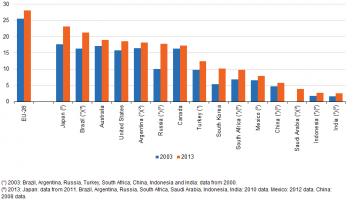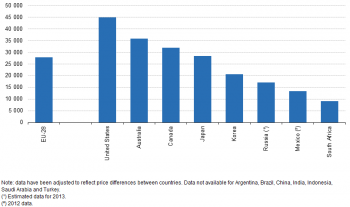Archive:The EU in the world - living conditions
- Data extracted from February to May 2016. Most recent data: Further Eurostat information, Main tables and Database. Planned article update: June 2018.

(% of GDP)
Source: Eurostat (spr_exp_sum), OECD (Social Expenditure Database) and ILO (Social Security Expenditure Database - multiple sources)

(% of total)
Source: Eurostat (ilc_lvph03), the United Nations Department of Economic and Social Affairs (Demographic statistics) and national surveys

(% of total household consumption expenditure)
Source: Eurostat (nama_10_gdp) and (demo_gind), , the United Nations Statistics Division (National Accounts Estimates of main aggregates) United Nations, Department of Economic and Social Affairs, Population Division (2015). World Population Prospects: The 2015 Revision, DVD Edition

(% of total household consumption expenditure)
Source: Eurostat (nama_10_co3_p3), the United Nations Statistics Division (Economic Statistics Branch, National Accounts Official Country Data) and national household surveys

(international USD)
Source: Eurostat (tec00113) and OECD (National Accounts at a Glance)

(%)
Source: Eurostat (ilc_di01) and the World Bank (Poverty and Inequality Database)
This article is part of a set of statistical articles based on Eurostat’s publication The EU in the world 2016.
The article focuses on living conditions and social protection in the European Union (EU) and in the 15 non-EU members of the Group of Twenty (G20). It covers indicators related to income, expenditure, poverty and social protection and gives an insight into society in the EU in comparison with the major economies in the rest of the world, such as its counterparts in the so-called Triad — Japan and the United States — and the BRICS.
Main statistical findings
Social protection expenditure
Social protection encompasses all actions by public or private bodies intended to relieve households and individuals from the burden of a defined set of risks or needs. Figure 1 shows the level of social protection expenditure in the G20 members relative to GDP.
The EU-28 recorded the highest level of expenditure on social protection in 2013, ahead of Japan (2011 data) and Brazil (2010 data), which were the only other G20 members (among the members for which data are available) with a ratio above 20 %. Saudi Arabia, Indonesia and India (all 2010 data) recorded social protection expenditure below 5 % of GDP. Social protection expenditure relative to GDP raised in all G20 countries between 2003 and 2013, with the most significant increase in South Korea (+ 89%) and Russia (+ 77%).
Household structure
Over half of households in India had five or more persons, compared with less than 10 % in the EU-28
Many statistical analyses of social and living conditions focus on households, in other words a person or group of persons living together (but separate from others), regardless of whether they are family members or not. Many factors influence household formation, for example, marriage, divorce, fertility and life expectancy, as well as geographical mobility, and economic and cultural factors.
Figure 2 shows that more than half of all households in the EU-28 in all G20 members (except India) were two- to four-person households, making them the most common among G20 members. The majority of households in India (57.0 %) had five or more persons, compared with less than one tenth in Russia, Canada, South Korea, Japan and the EU-28
Household expenditure and income
Household consumption expenditure is the expenditure made by households to acquire goods and services and includes indirect taxes (VAT and excise duties). Figure 3 presents expenditure statistics that have been adjusted to reflect differences in price levels across countries. The adjustment to reflect price level differences is done by converting data in national currencies to a common currency unit using purchasing power parities (PPPs) expressed in terms of international USD rather than market exchange rates. Among the G20 members household consumption expenditure per inhabitant was highest in the United States, Australia, Argentina and Canada, followed by the EU-28 and Japan (all above 20 000 international USD per inhabitant).
The share of expenditure on food and beverages was particularly low in the United States
Table 1 provides an analysis of the distribution of household consumption expenditure for various purposes. Factors such as culture, income, weather, household composition, economic structure and degree of urbanisation can all influence expenditure patterns. In most G20 members the highest proportion of expenditure was normally devoted to food and non-alcoholic beverages on one hand or housing (including expenditure for water and fuels) on the other. A notable exception to this general pattern was the United States where household expenditure on health had by far the highest share. The share of expenditure on food and beverages was particularly low in the United States, as it was to a lesser extent in Canada and Australia.
Disposable income was highest in the United States, Australia and Canada
Figure 4 presents information on income levels compiled by the OECD and Eurostat (for the EU-28) presented in international USD like in the case of Figure 3. Household adjusted disposable income reflects a household’s gross income including social transfers in-kind received (such as education and healthcare) minus taxes on income and wealth and social security contributions. The United States had the highest annual household adjusted income per inhabitant, followed at some distance by Australia, Canada, Japan and the EU-28.
The share of income accounted for by the highest income quintile was lowest in the EU-28 and highest in South Africa
Income generally has a major impact on an individual’s living conditions. Figure 5 presents the distribution of income for 2013 based on income shares, showing the proportion of all income received by the 20 % of the population with the highest income (the highest quintile), the proportion received by the 20 % of the population with the lowest income (the lowest quintile), and the proportion received by the three intermediate quintiles. Whereas in the EU-28 the proportion of income received by the highest quintile was 38.5 %, in all other G20 members for which data are available this proportion equalled or exceeded 40 % of the total, except Japan (39.7 %, 2008 data). The highest quintile received 68.9 % of all income in South Africa (2011 data), by far the highest proportion among the G20 members.
Data sources and availability
The indicators are often compiled according to international — sometimes global — standards. Although most data are based on international concepts and definitions there may be certain discrepancies in the methods used to compile the data.
EU data
Most of the indicators presented for the EU have been drawn from Eurobase, Eurostat’s online database. Eurobase is updated regularly, so there may be differences between data appearing in this article and data that is subsequently downloaded.
G20 members from the rest of the world
For the 15 non-EU G20 members, the data presented have been extracted from a range of international sources, namely the OECD, the United Nations Department of Economic and Social Affairs, the United Nations Statistics Division, and the World Bank. For some of the indicators shown a range of international statistical sources are available, each with their own policies and practices concerning data management (for example, concerning data validation, correction of errors, estimation of missing data, and frequency of updating). In general, attempts have been made to use only one source for each indicator in order to provide a comparable analysis between the members.
Context
The data on living conditions and social protection shown in this article aim to provide a picture of the social situation covering indicators related to income, expenditure, poverty and social protection. The distribution of income is often used to measure inequalities in society. On the one hand, differences in income may provide an incentive to individuals to improve their situation (for example, through looking for a new job or acquiring new skills). On the other hand, crime, poverty and social exclusion are often linked to income inequalities.
See also
- All articles on living conditions
- All articles on the non-EU countries
- Other articles from The EU in the world
Further Eurostat information
Publications
- Analytic report on subjective well-being
- Sport statistics
- People in the EU: who are we and how do we live? — 2015 edition
- European Neighbourhood Policy-East countries — Statistics on living conditions
- The European Union and the African Union — 2015 edition
- Asia-Europe Meeting (ASEM) — A statistical portrait — 2016 edition
- The EU in the world 2016
- European social statistics — 2013 edition
- Income and living conditions in Europe, 2010
- Key figures on the enlargement countries — 2014 edition
- Pocketbook on Euro-Mediterranean statistics — 2013 edition
- The European Union and the BRIC countries
- The European Union and the Republic of Korea — 2012
Main tables
- National accounts
- Annual sector accounts
- Real adjusted gross disposable income of households per capita (tec00113)
- Annual sector accounts
Database
- Income distribution and monetary poverty (ilc_ip)
- Monetary poverty (ilc_li)
- At-risk-of-poverty rate by poverty threshold, age and sex (source: SILC) (ilc_li02)
- Distribution of income (ilc_di)
- Distribution of income by quantiles (source: SILC) (ilc_di01)
- S80/S20 income quintile share ratio by sex and selected age group (Source: SILC) (ilc_di11)
- Monetary poverty (ilc_li)
- Living conditions (ilc_lv)
- Private households (ilc_lvph)
- Distribution of household size (source: SILC) (ilc_lvph03)
- Private households (ilc_lvph)
- Social protection (spr), see:
- Social protection expenditure (spr_expend)
- Expenditure: main results (spr_exp_sum)
- Main GDP aggregates (nama_10_ma)
- GDP and main components (output, expenditure and income) (nama_10_gdp)
- Detailed breakdowns of main GDP aggregates (by industry and consumption purpose) (nama_10_dbr)
- Final consumption expenditure of households by consumption purpose (COICOP 3 digit) (nama_10_co3_p3)
Dedicated section
- GDP and beyond
- Household Budget Surveys
- Income and Living Conditions
- Quality of life
- Social protection
Source data for tables and figures (MS Excel)
![]() Living conditions: tables and figures
Living conditions: tables and figures
External links
- OECD
- United Nations Department of Economic and Social Affairs
- United Nations Statistics Division
- World Bank